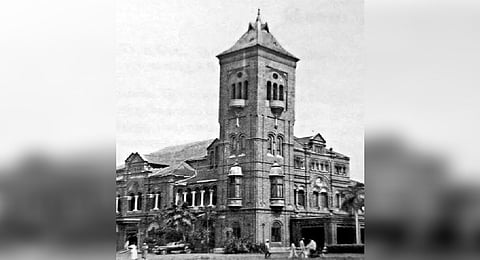

Most medieval European towns had a town hall and the British didn’t see Madras as any different. Throughout their initial history, town halls were places where elected officials gathered, and when they didn’t, the space was used for other purposes — cultural and social. But in Madras, the hall had absolutely no administrative use, with the Presidency being governed from the Fort and the Corporation from a rented building in Errabalu Street in Blacktown. The town hall in Madras would be a place where citizens could gather for other activities. And the responsibility of building the town hall also fell upon them.
Park Town at that time was the recreational hub in Madras when the Marina Beach was just a narrow sandy strip. The 117-acre park after which the area was named, would tempt the government to encroach upon it for new constructions. Victoria Public Hall was first in the list which ate into the park’s land. Later, the Nehru Stadium, Ripon Building, and the Suburban Railway building at Central all came up within its perimeter.
The government hinted that they would like to name the town hall after the Empress and as part of its responsibility, offered the 3.5 acres of land in Park Town on lease. The land was carved out of the People’s Park and leased for a century to a new trust formed. The hall had to pay a princely sum of Rs 28 as rent.
A significant portion of Madras’s cultural, social and political history transpired here. Ranging from the first cinema show, to the most effective social justice movement to evolve in this part of the country, to dramas with Shakespearean characters speaking in Tamil to the orations of Bharathi, Vivekananda and Annie Besant — the hall has seen it all.
The royalty of Madras rose to the occasion when it was learnt beyond doubt that the government would prefer to list the town hall project as part of the golden jubilee commemoration of Empress Victoria’s coronation. In January 1888, when the building commenced a citizens meeting, it was decided to name the hall after Queen Victoria.
The Maharaja of Vizianagaram, Sir Pusapati Ananda Gajapati Raju laid the foundation stone for the new building. Other royals who funded the hall included those from Travancore, Mysore, Pudukottai Ramnad, Ettaiyapuram as well. In spite of the donations of such benefactors, a lottery helped plug the shortfall in funding.
The architect Robert Chisholm, who had been the Executive Engineer of Bengal PWD in Puri Division, moved to Madras and contributed to changing its skyline with a series of Indo-Saracenic buildings incorporating both Hindu and Mughal elements in the facade and interiors.
The hall, which took about five years to construct, seems to have started off as an Indo-Saracenic structure. But Chisholm was experimenting with other aspects of Indian architecture as well. His tryst with the Malabar school influenced the tiled roof of the hall — much like the Napier Museum in Trivandrum named after the Governor of Madras. Chisholm, using the lightness of the Mangalore tiles to his advantage, made a tall ceiling and introduced an intermediate floor of Madras Terrace serving as the balcony to host viewers.
T Namberumal Chetty, the biggest contractor at that time, was entrusted with the project. The bricks were moved down the Cooum from Choolaimedu and lime mortar was ground on site with grinding stones operated by bullocks.
When the hall was thrown open by the Governor, there was a waiting list to hire it. Swami Vivekananda, after his successful journey to Chicago, saw more people standing outside the hall than those seated within. Standing atop a nearby bullock cart, he compared his oration to Krishna’s sermon atop a chariot in the Gita. Bharathi spoke on the ‘cult of the eternal’ and the tickets were priced at one rupee.
Tamil theatre had evolved from this hall. The pioneers of Tamil drama, Sankaradas Swamigal and Pammal Sambanda Mudaliar, have staged their plays at the hall. While until then, Tamil theatre functioned only from late night to dawn, Mudaliar introduced the first evening shows at the hall, attracting family audiences for the first time.
At the hall, Shakespeare’s characters spoke in Tamil for the first time, with performances of Jwalita Ramanan (Romeo and Juliet), Vannipurathu Vanigan (The Merchant of Venice), among others. On May 7, 1915, Mohandas Karamchand Gandhi was an attendee at Mudaliar’s play Harichandra. None of the local press covered the arrival as Gandhi was not yet the Mahatma and not many recognised him.
Politics and cinema had a surprising connection with this hall. It was here that the first cinema screening was held in Madras in December 1896 when a cyclone was raging across the city. T Stevenson, the proprietor of the Madras Photographic Store, ran ten short films to an almost empty hall, triggering a cultural revolution.
On November 20, 1916, 30 prominent non-Brahmin leaders came together to form the South Indian Liberation Federation (SILF) also known as the Justice Party, which led to the emergence of Dravidian politics in the state.
Visit news.dtnext.in to explore our interactive epaper!
Download the DT Next app for more exciting features!
Click here for iOS
Click here for Android